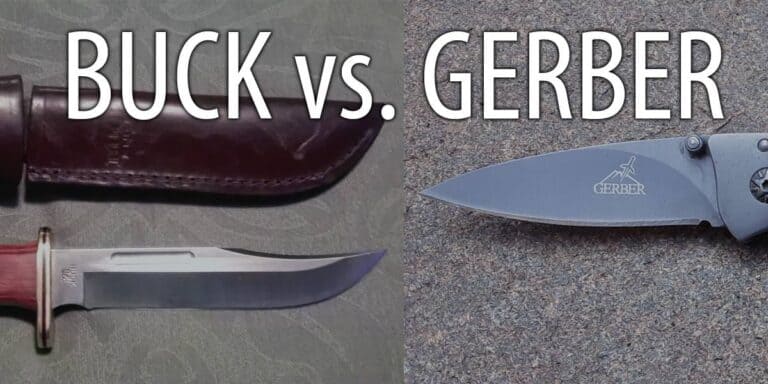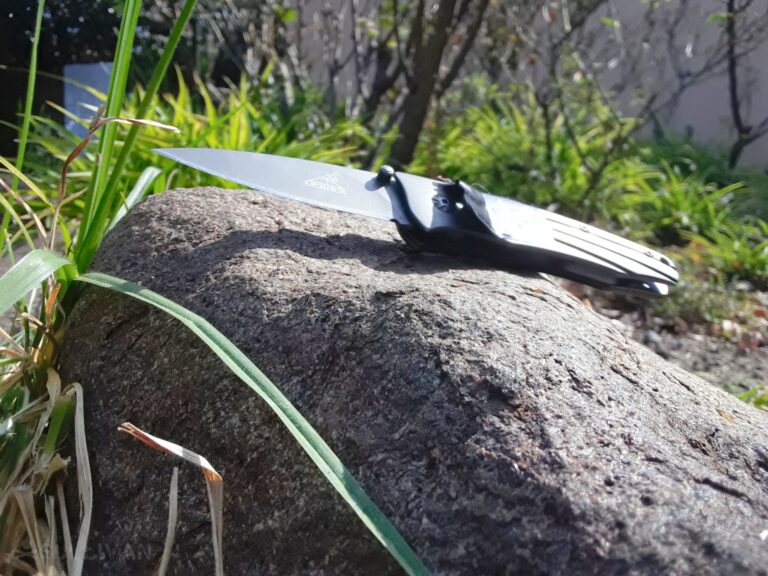When it comes to brand recognition, Buck and Gerber knives have been around for years and have developed a dedicated clientele.

Buck and Gerber have both got extensive catalogs with a variety of blade options, and both are popular with knife enthusiasts – although, I’d say that Buck is probably the more popular of the two.
That said, we’re not here to look at popularity per-se; we want to know which brand is objectively better, Buck or Gerber?
Which is better between Gerber and Buck? Buck Knives is the better brand. Their blades have a better heat treatment, and they tend to use higher-end steels for better strength, durability, and edge retention.
The only issue with Buck Knives is that their blades can be harder to sharpen. Gerber, on the other hand, has a different heat treat which results in a lower quality blade.
The company has more hit and miss moments than Buck Knives, with products frequently being recalled.
Direct Comparison Chart for Buck and Gerber Knives
Here is a high level overview of the similarities and differences between Buck and Gerber knives.
| Feature | Buck Knives | Gerber Knives |
|---|---|---|
| Blade Steel | Regular knives 420 high carbon stainless steel S30V Sandvik knife steel 5160 Spring steel CM154 Sandvik Steel 13C26 Sandvik Steel | Stainless steel for most of their blades. Steel types include: 420HC 7Cr17MOV 0S30V |
| Knife Handle Material | Rubber Micarta Wood Metal | Plastic Thermoplastic Metal |
| Price | Between $50 and $200+ | Between $30 and $200 |
| Warranty | Lifetime warranty as long as damage wasn’t caused by the user | 25 year warranty as long as there is no misuse of the knife |
Buck Knives
The Buck Knives company is based in Idaho and got its start in 1902 with Hoyt Buck and has continued to be run by the Buck family. It started out with Hoyt making 25 knives each week by hand until he passed away in 1949. The company passed to his son and has been passed down, father to son, ever since.
What Makes Buck Knives Good?
- Buck has a company-exclusive heat-treating process which adds extra edge retention and durability to their blades.
- They use stainless steel in their blades. The standard knives use 420 high carbon stainless which is corrosion-resistant and easy to sharpen. They also use 5160 Spring Steel, S30V, CM154, and 13C26 Sandvik steels which have great edge retention and durability but are much harder to sharpen yourself.
- Handle materials also vary from rubber to micarta to wood and/or metal and each material is designed for superior grip, comfort, durability, and aesthetics.
- The company’s forever warranty covers the entire life of a knife and applies as long as the defect/damage wasn’t caused by misuse of the knife.
Additionally, and this is probably going to be a more personal thing, the blades aren’t very tactical looking. You can use them for almost anything both indoors and outdoors with little problem.
What Makes Buck Knives Bad?
The only issue that I was able to find in relation to Buck Knives is that some of their blades are difficult to sharpen as they use a harder steel.
Gerber
Based in Portland, Oregon, Gerber started out as an ad agency in 1910 which did a delivery of handmade kitchen knives. They entered the knife world in 1939, when a company called Abercrombie and Fitch requested a large quantity of knives for their catalog.

Over the years, they produced a variety of blades and then moved into multitools. They’re perhaps best-known for their collaborations with Bear Grylls on knives and tools – and for the frequent recalls of those tools.
What Makes Gerber Knives Good?
- Gerber is known for their tank-like military/tactical knives (i.e. the Strongarm) which can take a beating. Their use of stainless steels in their blades gives a bit of corrosion-resistance and strength to the edges. There is a large selection of blade styles and color schemes from which to choose so you can pick your poison. Steels used include 7Cr17MOV, S30V, and 420HC Stainless.
- Handle materials will vary between models and no two models will be the same. These handles are, generally, comfortable to hold.
- There is a limited lifetime warranty attached to Gerber products within the USA; outside of the USA, the warranty is good for 25 years.
What Makes Gerber Knives Bad?
- The heat treatment used by Gerber on their 420HC stainless blades isn’t quite as good as the treatment given by Buck Knives. This lowers the quality of the blades in a lot of cases.
- Tying into the previous point, many of Gerber’s knives and tools are viewed as overpriced; especially when you consider that you may end up with a lower quality blade in comparison to Buck Knives.
- Many of the knives boast somewhat aggressive blade profiles which might not be a problem if you’re in the military or law enforcement, but it may put ordinary Joes off of buying them.
There’s also a slight issue with the warranty in that it only covers product defects; not damage caused by use of their products. This means that it only covers a knife/tool that’s defective out-of-the-box. If your knife/tool breaks while you’re using it, you have to buy a new one.
Final Verdict
Let’s Recap:
Buck Knives uses harder, premium stainless steels, and a superior heat treatment on their blades, ensuring a higher quality product, with added strength, durability, and edge retention. The only downside to this is that the blades can be much harder to sharpen.
The various handle materials are all stylish and comfortable to hold and the warranty covers everything – except for damage by misuse – for the lifetime of the knife.
Gerber also uses stainless steels in their knives but the heat treatment isn’t as good, and the resulting blade is of lower quality. The knives themselves are generally comfortable in-hand and are usually sharpened easily.
However, some of the knives are frequently recalled and the company’s products are largely viewed as overpriced for what you’re getting. The warranty only covers out-of-the-box defects, it doesn’t cover damage by use meaning you have to buy a new blade if your knife/tool breaks while in use.
Now, the question of: ‘which is better?’ is a bit unfair as experiences and preferences will be different for everyone. With that said, however, based on what I found, I would say that Buck Knives is the superior brand.
That doesn’t mean Gerber is a bad brand, it just means that Buck has a better-quality product overall. All companies have a few misses here and there, but Gerber seems to see more misses than Buck Knives does.
As always, I’d like to thank you all so much for reading. I hope you enjoyed the article and found it informative and/or helpful. Thanks for reading and I’ll see you in the next one very soon. Take care.
Questions You May have…
Whether you’re looking for a full tang knife or a simple pocket knife, there is a lot of choices available on the market. Here are some of the most popular questions people have about the knife industry, specifically around Buck and Gerber brands.
The Buck 110 has a durable blade that makes a classic outdoor every day carry. The entire knife, right to the pommel is heat treated for high wear resistance.
The Ontario MK 3 Navy Knife is commonly given to all Navy Seals. They have durable knife blades and made for a great survival/hunting knife.
While both brands are recognizable and well received, Buck knives tend to use better steel with their knives having more durability.

Greg spent much of his younger years camping and hiking. Greg grew up on a small farm with lots of livestock such as cows, horses and chickens. He’s good with a bow and arrow, is a huge knife enthusiast, and has a blackbelt in Taekwondo.
